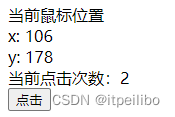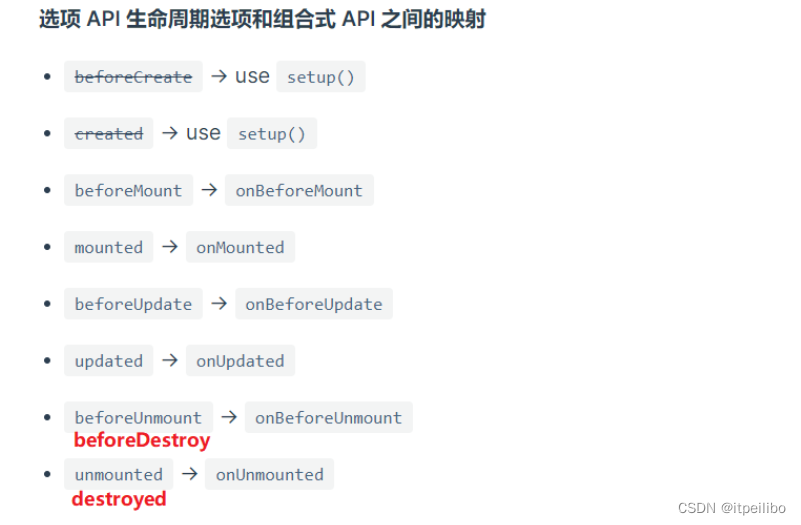Vue3详细讲解
作者:小教学发布时间:2023-09-28分类:程序开发学习浏览:197
Vue 3 介绍
文章目录
- Vue 3 介绍
- 为什么要学习 vue 3
- Vue3 动机 和 新特性
- Vite 的使用
- vite介绍
- 为什么选 Vite ?
- Vite 的基本使用
- Vue3.0项目介绍
- vscode插件说明
- 组合式API
- composition API vs options API
- 体验 composition API
- setup 函数
- reactive 函数
- ref 函数
- script setup语法(★)
- 计算属性computed函数
- 侦听器watch函数
- 钩子函数的使用
- 组件通讯-父传子
- 组件通讯-子传父
- 依赖注入 - provide 和 inject
- 模板中 ref 的使用
- vue3中废弃了过滤器
- 补充-toRefs 函数
- vue-router4
- 基本使用
- 组件中使用route与router
- vuex4
- 基本使用
- 在组件中使用vuex
为什么要学习 vue 3

为什么要学vue3:
- Vue是国内最火的前端框架
- Vue 3 于 2022 年 2 月 7 日星期一成为新的默认版本!
- 原文链接:https://blog.vuejs.org/posts/vue-3-as-the-new-default.html
- 中文链接:https://zhuanlan.zhihu.com/p/460055155
- Vue3性能更高,体积更小
- Vue3.0在经过一年的迭代后,越来越好用
官方文档:
- vue3官方文档:https://vuejs.org/
- vue3中文文档:https://v3.cn.vuejs.org/
目前已支持 vue3 的UI组件库:
-
element-plus
https://element-plus.gitee.io/#/zh-CN (PC组件库)
Element Plus,一套为开发者、设计师和产品经理准备的基于 Vue 3.0 的桌面端组件库。
-
vant
https://vant-contrib.gitee.io/vant/v3/#/zh-CN
轻量、可靠的移动端 Vue 组件库。
Vant 是有赞前端团队开源的移动端组件库,于 2016 年开源,已持续维护 4 年时间。
目前 Vant 已完成了对 Vue 3.0 的适配工作,并发布了 Vant 3.0 版本
-
ant-design-vue (PC组件库)
https://antdv.com/docs/vue/introduce-cn/
ant-design-vue 是 Ant Design 的 Vue 实现,组件的风格与 Ant Design 保持同步
Vue3 动机 和 新特性
Vue3 设计理念 https://vue3js.cn/vue-composition/
动机与目的:
-
更好的逻辑复用 与 代码组织 (composition组合式api)
optionsAPI(旧) => compositionAPI(新), 效果: 代码组织更方便了, 逻辑复用更方便了 非常利于维护!!
-
更好的类型推导 (typescript支持)
vue3 源码用 ts 重写了, vue3 对 ts 的支持更友好了 (ts 可以让代码更加稳定, 类型检测! )
vue3新特性:
-
数据响应式原理重新实现 (ES6 proxy 替代了 ES5 的 Object.defineProperty)
解决了: 例如数组的更新检测等bug, 大大优化了响应式监听的性能
(原来检测对象属性的变化, 需要一个个对属性递归监听) proxy 可以直接对整个对象劫持
-
虚拟DOM - 新算法 (更快 更小)
-
提供了composition api, 可以更好的逻辑复用
-
模板可以有多个根元素
-
源码用 typescript 重写, 有更好的类型推导 (类型检测更为严格, 更稳定)
…
小结: vue3 性能更高, 体积更小, 更利于复用, 代码维护更方便
Vite 的使用

webpack => 实时打包(服务器) => 浏览器运行
vite => 直接编译输出 => 将一部分模块化依赖加载解析的功能 交给了浏览器
vite介绍
Vite 官方文档:https://cn.vitejs.dev/
Vite(法语意为 “快速的”,发音 /vit/,发音同 “veet”)是一种新型前端构建工具
优势
- 💡 极速的服务启动,使用原生 ESM 文件,无需打包
- ⚡️ 轻量快速的热重载,始终极快的模块热重载(HMR)
- 🛠️丰富的功能,对 TypeScript、JSX、CSS 等支持开箱即用
- 📦等等
为什么选 Vite ?
传统方式
- 基于打包器的方式启动,必须优先抓取并构建你的整个应用,然后才能提供服务。
- 更新速度会随着应用体积增长而直线下降。

vite 方式
- Vite 以 原生 ESM 方式提供源码。这实际上是让浏览器接管了打包程序的部分工作。
- Vite 只需要在浏览器请求源码时进行转换并 按需提供源码。
- 根据情景动态导入代码,即只在当前屏幕上实际使用时才会被处理。

问题小结:
- Vite 是否需要先打包才能提供服务?
- 使用webpack能否创建vue3的项目? webpack也能构建 vue3
Vite 的基本使用
目标:能够使用vite创建一个vue3的项目
(1)使用vite创建项目
npm create vite
# or
yarn create vite
(2)输入项目名字,默认为vite-project

(3)选择创建的项目类型,选择vue即可

(4)选择创建的vue项目类型, 不选ts

(5)启动项目

vite快捷使用
如果想要快速创建一个vue3项目,可以使用如下命令
- 创建普通vue项目
yarn create vite vite-demo --template vue
- 创建基于ts模板的项目
yarn create vite vite-demo-ts --template vue-ts
Vue3.0项目介绍
任务目标:掌握vue3的项目目录结构
-
删除src下所有的文件和代码
-
创建App.vue
<template>
<div>我是App组件</div>
</template>
- 创建main.js文件
import { createApp } from 'vue'
import App from './App.vue'
createApp(App).mount('#app')
vscode插件说明
- vue2中需要安装插件
vetur,可以实现组件高亮。但是vue3的一些语法在vetur中报错。 - vue3中需要安装插件
volor,提供了更加强大的功能。 - 所以,使用功能vue3,需要卸载
vetur插件,安装volar插件。

组合式API
composition API vs options API
-
vue2 采用的就是
optionsAPI(1) 优点:
易于学习和使用, 每个代码有着明确的位置 (例如: 数据放 data 中, 方法放 methods中)(2) 缺点: 相似的逻辑, 不容易复用, 在大项目中尤为明显
(3) 虽然 optionsAPI 可以通过mixins 提取相同的逻辑, 但是也并不是特别好维护
-
vue3 新增的就是
compositionAPI(1) compositionAPI 是基于 逻辑功能 组织代码的, 一个功能 api 相关放到一起
(2) 即使项目大了, 功能多了, 也能快速定位功能相关的 api
(3) 大大的提升了
代码可读性和可维护性 -
vue3 推荐使用 composition API, 也保留了options API
即就算不用composition API, 用 vue2 的写法也完全兼容!!
问题小结: optionsAPI的优缺点是什么? vue3 新增的 compositionAPI 有什么特征? 有什么优势?
体验 composition API
需求: 鼠标移动显示鼠标坐标 x, y

options API 版本
<template>
<div>当前鼠标位置</div>
<div>x: {{ mouse.x }}</div>
<div>y: {{ mouse.y }}</div>
<div>当前点击次数:{{ count }}</div>
<button @click="add">点击</button>
</template>
<script>
export default {
// vue2 中采用的是 options API
// 常见的配置项: data created methods watch computed components
data() {
return {
mouse: {
x: 0,
y: 0,
},
count: 0,
}
},
mounted() {
document.addEventListener('mousemove', this.move)
},
methods: {
move(e) {
this.mouse.x = e.pageX
this.mouse.y = e.pageY
},
add() {
this.count++
},
},
destroyed() {
document.removeEventListener('mousemove', this.move)
},
}
</script>
composition API 版本
<template>
<div>当前鼠标位置</div>
<div>x: {{ mouse.x }}</div>
<div>y: {{ mouse.y }}</div>
<div>当前点击次数:{{ count }}</div>
<button @click="add">点击</button>
</template>
<script>
import { onMounted, onUnmounted, reactive, ref } from 'vue'
export default {
setup() {
const count = ref(0)
const add = () => {
count.value++
}
const mouse = reactive({
x: 0,
y: 0,
})
const move = (e) => {
mouse.x = e.pageX
mouse.y = e.pageY
}
onMounted(() => {
document.addEventListener('mousemove', move)
})
onUnmounted(() => {
document.removeEventListener('mousemove', move)
})
return {
count,
add,
mouse,
}
},
}
</script>
抽离逻辑
function useMouse() {
const mouse = reactive({
x: 0,
y: 0,
})
const move = (e) => {
mouse.x = e.pageX
mouse.y = e.pageY
}
onMounted(() => {
document.addEventListener('mousemove', move)
})
onUnmounted(() => {
document.removeEventListener('mousemove', move)
})
return mouse
}
function useCount() {
const count = ref(0)
const add = () => {
count.value++
}
return {
count,
add,
}
}
问题小结: optionsAPI的优缺点是什么? vue3 新增的 compositionAPI 有什么特征? 有什么优势?
optionsAPI:
- 优点:
易于学习和使用, 每个代码有着明确的位置 - 缺点: 相似的逻辑, 不容易复用
compositionAPI:
- 基于 逻辑功能 组织代码
- 可维护性好!
setup 函数
composition api的使用, 需要配置一个setup 函数
- setup 函数是一个新的组件选项, 作为组件中 compositionAPI 的起点
- 从生命周期角度来看, setup 会在 beforeCreate 钩子函数之前执行
- setup 中不能使用 this, this 指向 undefined
- 在模版中需要使用的数据和函数,需要在
setup返回。
<template>
<div class="container">
<h1 @click="say()">{{msg}}</h1>
</div>
</template>
<script>
export default {
setup () {
console.log('setup执行了')
console.log(this)
// 定义数据和函数
const msg = 'hi vue3'
const say = () => {
console.log(msg)
}
return { msg , say}
},
beforeCreate() {
console.log('beforeCreate执行了')
console.log(this)
}
}
</script>
reactive 函数
前置说明:
- setup 需要有返回值, 只有返回的值才能在模板中使用
- 默认普通的数据, 不是响应式的
作用: 传入一个复杂数据类型,将复杂类型数据, 转换成响应式数据 (返回该对象的响应式代理)
<template>
<div>{{ obj.name }}</div>
<div>{{ obj.age }}</div>
<button @click="obj.name = 'ls'">改值</button>
</template>
<script>
import { reactive } from 'vue'
export default {
setup () {
// 1. setup 需要返回值, 返回的值才能在模板中使用
// 2. 默认的普通的值不是响应式的, 需要用 reactive 函数
const obj = reactive({
name: 'zs',
age: 18
})
return {
obj
}
}
}
</script>
总结: 通常是用来定义响应式 对象数据
问题小结:
- 默认 setup 函数中返回的 普通对象 是响应式的么 ?
- reactive 函数的作用是什么 ?
ref 函数
reactive 处理的数据, 必须是复杂类型, 如果是简单类型无法处理成响应式, 所以有 ref 函数!
作用: 对传入的数据(一般简单数据类型),包裹一层对象, 转换成响应式。
- ref 函数接收一个的值, 返回一个ref 响应式对象, 有唯一的属性 value
- 在 setup 函数中, 通过 ref 对象的 value 属性, 可以访问到值
- 在模板中, ref 属性会自动解套, 不需要额外的 .value
- ref函数也支持传入复杂类型,传入复杂类型,也会做响应式处理
<template>
<div>{{ money }}</div>
<button @click="money++">改值</button>
</template>
<script>
import { reactive, ref } from 'vue'
export default {
setup() {
let money = ref(100)
money.value++
return {
money
}
}
}
</script>
ref 和 reactive 的最佳使用方式:
- 明确的对象,明确的属性,用reactive,其他用 ref
- 从vue3.2之后,更推荐使用ref (ref底层性能做了提升 => 260%)
问题小结:
- ref 函数的作用是什么 ?
- ref 函数包裹简单类型后, 会包裹成对象, 在模板中需要 .value 么? 在 setup 中需要 .value 么?
script setup语法(★)
script setup是在单文件组件 (SFC) 中使用组合式 API 的编译时语法糖。相比于普通的 script 语法更加简洁
要使用这个语法,需要将 setup attribute 添加到 <script> 代码块上:
<script setup>
console.log('hello script setup')
</script>
顶层的绑定会自动暴露给模板,所以定义的变量,函数和import导入的内容都可以直接在模板中直接使用
<template>
<div>
<h3>根组件</h3>
<div>点击次数:{{ count }}</div>
<button @click="add">点击修改</button>
</div>
</template>
<script setup>
import { ref } from 'vue'
const count = ref(0)
const add = () => {
count.value++
}
</script>
计算属性computed函数
computed函数调用时, 要接收一个处理函数, 处理函数中, 需要返回计算属性的值
<template>
<div>我今年的年纪 <input type="text" v-model="age" /></div>
<div>我明年的年龄 {{ nextAge }}</div>
<div>我后年的年龄 <input type="text" v-model="nextAge2" /></div>
</template>
<script setup>
import { computed, ref } from 'vue'
const age = ref(10)
// 不带set的计算属性
const nextAge = computed(() => {
return +age.value + 1
})
// 带set的计算属性
const nextAge2 = computed({
get() {
return +age.value + 2
},
set(value) {
age.value = value - 2
},
})
</script>
问题小结: computed 函数提供计算属性, 有几种写法?
侦听器watch函数
watch监视, 接收三个参数
1. 参数1: 监视的数据源
2. 参数2: 回调函数
3. 参数3: 额外的配置
// 监听单个ref
const money = ref(100)
watch(money, (value, oldValue) => {
console.log(value)
})
// 监听多个ref
const money = ref(100)
const count = ref(0)
watch([money, count], (value) => {
console.log(value)
})
// 监听ref复杂数据
const user = ref({
name: 'zs',
age: 18,
})
watch(
user,
(value) => {
console.log('user变化了', value)
},
{
// 深度监听,,,当ref的值是一个复杂数据类型,需要深度监听
deep: true,
immediate: true
}
)
// 监听对象的某个属性的变化
const user = ref({
name: 'zs',
age: 18,
})
watch(
() => user.value.name,
(value) => {
console.log(value)
}
)
钩子函数的使用
生命周期函数 vue3 中的生命周期函数, 需要在 setup 中调用
import { onMounted, onUpdated, onUnmounted } from 'vue'
const MyComponent = {
setup() {
onMounted(() => {
console.log('mounted!')
})
onUpdated(() => {
console.log('updated!')
})
onUnmounted(() => {
console.log('unmounted!')
})
}
}

组件通讯-父传子
目标:能够实现组件通讯中的父传子组件通讯
步骤:
- 父组件提供数据
- 父组件将数据传递给子组件
- 子组件通过defineProps进行接收
- 子组件渲染父组件传递的数据
核心代码:
父组件
<script setup>
import { ref } from 'vue'
// 在setup语法中,组件导入之后就能够直接使用,不需要使用components进行局部注册
import Son from './components/Son.vue'
const money = ref(100)
const car = ref('玛莎拉蒂')
</script>
<template>
<div>
<h1>我是父组件</h1>
<div>金钱:{{ money }}</div>
<div>车辆:{{ car }}</div>
<hr />
<Son :money="money" :car="car"></Son>
</div>
</template>
<style lang="less" scoped></style>
子组件
<script setup>
import { computed } from 'vue'
// defineProps: 接收父组件传递的数据
const props = defineProps({
money: Number,
car: String,
})
const myMoney = computed(() => {
return props.money + 100
})
</script>
<template>
<div>
<h3>我是子组件</h3>
<div>{{ money }} --- {{ car }}</div>
</div>
</template>
<style lang="less" scoped></style>
注意:如果使用defineProps接收数据,这个数据只能在模板中渲染,如果想要在script中也操作props属性,应该接收返回值。
组件通讯-子传父
目标:能够实现组件通讯中的子传父
步骤:
- 子组件通过defineEmit获取emit对象(因为没有this)
- 子组件通过emit触发事件,并且传递数据
- 父组件提供方法
- 父组件通过自定义事件的方式给子组件注册事件
核心代码
子组件
<script setup>
defineProps({
money: Number,
car: String,
})
const emit = defineEmits(['changeMoney'])
const change = () => {
emit('changeMoney', 10)
}
</script>
父组件
<script setup>
import { ref } from 'vue'
// 在setup语法中,组件导入之后就能够直接使用,不需要使用components进行局部注册
import Son from './components/Son.vue'
const money = ref(100)
const car = ref('玛莎拉蒂')
const changeMoney = (num) => {
money.value = money.value - num
}
</script>
<Son :money="money" :car="car" @changeMoney="changeMoney"></Son>
依赖注入 - provide 和 inject
依赖注入, 可以非常方便的实现 跨层级的 组件通信

父组件利用 provide 提供数据
<script setup>
import { provide, ref } from 'vue'
import Son from './components/Son.vue'
const money = ref(100)
provide('money', money)
</script>
<template>
<div>
<h1>我是父组件</h1>
<div>金钱:{{ money }}</div>
<hr />
<Son></Son>
</div>
</template>
<style lang="less" scoped></style>
子组件 (子孙后代, 都可以拿到这个数据)
<script setup>
import { inject } from 'vue'
const money = inject('money')
</script>
<template>
<div>
<h3>我是子组件--{{ money }}</h3>
<button>修改数据</button>
</div>
</template>
<style lang="less" scoped></style>
如果希望子传父, 可以 provide 传递一个方法
父组件
<script setup>
import { provide, ref } from 'vue'
import Son from './components/Son.vue'
const money = ref(100)
const changeMoney = (num) => {
money.value = money.value - num
}
provide('money', money)
provide('changeMoney', changeMoney)
</script>
子组件
<script setup>
import { inject } from 'vue'
const money = inject('money')
const changeMoney = inject('changeMoney')
</script>
模板中 ref 的使用
联想之前的 ref 和 $refs, 获取模板的元素(dom元素,组件)
1 创建 ref => const hRef = ref(null)
2 模板中建立关联 => <h1 ref="hRef">钩子函数-----123</h1>
3 使用 => hRef.value
<script setup>
import { ref } from 'vue'
const hRef = ref(null)
const clickFn = () => {
hRef.value.innerText = '我不是标题'
}
</script>
<template>
<div>
<h1 ref="hRef">我是标题</h1>
<button @click="clickFn">操作DOM</button>
</div>
</template>
ref操作组件
<script setup>
import { ref } from 'vue'
import Form from './components/Form.vue'
// 1. 提供一个ref
const formRef = ref(null)
const fn = () => {
console.log(formRef.value.count)
formRef.value.validate()
}
</script>
<template>
<Form ref="formRef"></Form>
</template>
需要配合defineExpose
<script setup>
import { ref } from 'vue'
const count = ref(0)
const validate = () => {
console.log('表单校验方法')
}
// 暴露属性给外部组件使用
defineExpose({
count,
validate,
})
</script>
<template>
<h3>我是Form组件</h3>
</template>
vue3中废弃了过滤器
vue3.0中不能使用过滤器,直接使用函数进行替代
<template>
<h1>ref的使用</h1>
<h3>我是一个h3的内容 {{ formatTime(now) }}</h3>
<h3>{{ formatTime(other) }}</h3>
<hr />
</template>
<script>
import moment from 'moment'
export default {
setup() {
// 过滤器
const now = new Date()
const other = new Date('2020-11-12 12:00:00')
const formatTime = (value) => {
return moment(value).format('YYYY-MM-DD')
}
return {
now,
formatTime,
other,
}
},
}
</script>
补充-toRefs 函数
使用场景: 如果对一个响应数据, 进行解构 或者 展开, 会丢失他的响应式特性!
原因: vue3 底层是对 对象 进行监听劫持
作用: 对一个响应式对象的所有内部属性, 都做响应式处理
- reactive/ref的响应式功能是赋值给对象的, 如果给对象解构或者展开, 会让数据丢失响应式的能力
- 使用 toRefs 可以保证该对象展开的每个属性都是响应式的
<template>
<div>{{ money }}</div>
<div>{{ car }}</div>
<div>{{ name }}</div>
<button @click="money++">改值</button>
</template>
<script setup>
import { reactive, ref, toRefs } from 'vue'
const user = ref({
name: 'zs',
age: 18,
})
const { name, age } = toRefs(user.value)
</script>
问题小结: toRefs 函数的作用是什么 ?
作用: 对一个 响应式对象 的所有内部属性, 都做响应式处理, 保证展开或者解构出的数据也是响应式的
vue-router4
vue升级vue3之后,配套的vue-router也升级为vue-router@4.x版本
vue-router4的语法和3的版本语法基本一致,但是有一些细微的修改。
vue-router官网:https://router.vuejs.org/
vue@2 + vue-router@3 + vuex@3 options api
vue@3 + vue-router@4 + vuex@4 composition api
基本使用
(0)安装vue-router
yarn add vue-router
(1)创建组件Home.vue和Login.vue
(2)创建文件router/index.js
import {
createRouter,
createWebHashHistory,
createWebHistory,
} from 'vue-router'
// 1. 创建路由
const router = createRouter({
// 创建history模式的路由
// history: createWebHistory(),
// 创建hash模式的路由
history: createWebHashHistory(),
// 配置路由规则
routes: [
{ path: '/home', component: () => import('../pages/Home.vue') },
{ path: '/login', component: () => import('../pages/Login.vue') },
],
})
export default router
(3)在main.js中引入
import { createApp } from 'vue'
import App from './App.vue'
import router from './router'
createApp(App).use(router).mount('#app')
(4)App.vue中使用
<template>
<ul>
<li>
<router-link to="/home">首页</router-link>
</li>
<li>
<router-link to="/login">登陆</router-link>
</li>
</ul>
<!-- 路由出口 -->
<router-view></router-view>
</template>
组件中使用route与router
由于组件中无法访问this,因为无法访问this. r o u t e 与 t h i s . route与this. route与this.router
(1)通过useRoute()可以获取route信息
<script>
import { useRoute } from 'vue-router'
export default {
setup() {
const route = useRoute()
console.log(route.path)
console.log(route.fullPath)
},
}
</script>
(2)通过useRouter()可以获取router信息
<script>
import { useRouter } from 'vue-router'
export default {
setup() {
const router = useRouter()
const login = () => {
router.push('/home')
}
return {
login,
}
},
}
</script>
vuex4
基本使用
- 安装依赖包
yarn add vuex
- 创建文件 store/index.js
import { createStore } from 'vuex'
const store = createStore({
state: {
money: 100,
},
mutations: {
changeMoney(state) {
state.money += 10
},
},
actions: {
changeMoneyAsync(context) {
setTimeout(() => {
context.commit('changeMoney')
}, 1000)
},
},
getters: {
double(state) {
return state.money * 2
},
},
})
export default store
- 在main.js中关联store
import { createApp } from 'vue'
import App from './App.vue'
import router from './router'
import store from './store'
const app = createApp(App)
app.use(router)
app.use(store)
app.mount('#app')
在组件中使用vuex
const store = useStore()
const money = computed(() => store.state.money)
const double = computed(() => store.getters.double)
// mapState mapMutations mapActions mapGetters 需要配合options api才能使用
总结:vuex4 在vue3项目中能用,但是不好用
- 程序开发学习排行
- 最近发表


